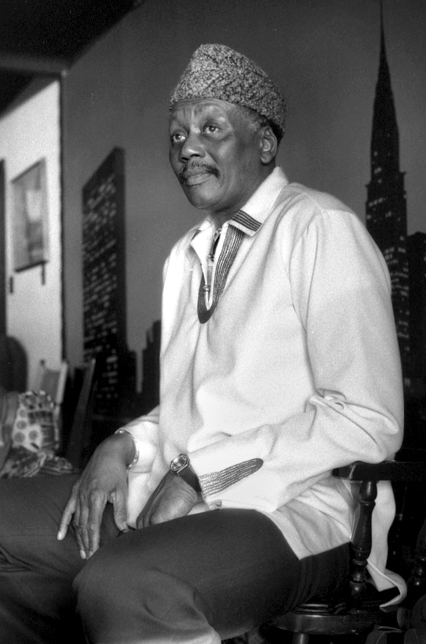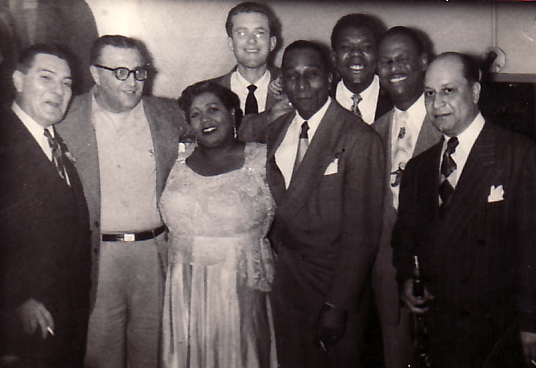|
Get Happy With The Randy Weston Trio
''Get Happy with the Randy Weston Trio'' is a jazz album by American jazz pianist Randy Weston recorded in 1955 and released on the Riverside label. accessed August 9, 2012. Reception The Allmusic review by Jim Todd stated: "This early release from Randy Weston finds the pianist still in his formative stages... The set shows Weston's facility with standards, Ellingtonia, even ragtime, but, with several tracks coming in well under four minutes, the performances offer little room for development. The impression here is that of a pianist of great potential limbering up before the curtain rises for the show".Todd, J[...More Info...] [...Related Items...] OR: [Wikipedia] [Google] [Baidu] |
Randy Weston
Randolph Edward "Randy" Weston (April 6, 1926 – September 1, 2018) was an American jazz pianist and composer whose creativity was inspired by his ancestral African connection. Weston's piano style owed much to Duke Ellington and Thelonious Monk, whom he cited in a 2018 video as among pianists he counted as influences, as well as Count Basie, Nat King Cole and Earl Hines."Randy Weston talks about his new solo double CD Sound" YouTube video, March 27, 2018. Beginning in the 1950s, Weston worked often with trombonist and arranger Melba Liston. Described as "America's African Musical Ambassador", Weston once said: "What I do I do because it's about teaching and informing everyone about our most natural cultural phenomenon. It's really about Africa a ... [...More Info...] [...Related Items...] OR: [Wikipedia] [Google] [Baidu] |
Harold Adamson
Harold Campbell Adamson (December 10, 1906 – August 17, 1980) was an American lyricist during the 1930s and 1940s. Early life Adamson, the son of building contractor Harold Adamson and Marion "Minnie" Campbell Adamson, was born and raised in Greenville, New Jersey, United States. Adamson suffered from polio as a child which limited the use of his right hand. Initially, Adamson was interested in acting, but he began writing songs and poetry as a teenager. He went on to studying acting at the University of Kansas and Harvard. Career Ultimately he entered into a songwriting contract with MGM in 1933. During his stint with MGM, he was nominated for five Academy Awards. Among his best-known compositions was the theme for the hit sitcom, ''I Love Lucy''. He retired from songwriting in the early 1960s, and was inducted into the Songwriters Hall of Fame in 1972. In 1941, he collaborated with Pierce Norman, and baseball's Joe DiMaggio to write "In the Beauty of Tahoe", published b ... [...More Info...] [...Related Items...] OR: [Wikipedia] [Google] [Baidu] |
Double Bass
The double bass (), also known simply as the bass () (or #Terminology, by other names), is the largest and lowest-pitched Bow (music), bowed (or plucked) string instrument in the modern orchestra, symphony orchestra (excluding unorthodox additions such as the octobass). Similar in structure to the cello, it has four, although occasionally five, strings. The bass is a standard member of the orchestra's string section, along with violins, viola, and cello, ''The Orchestra: A User's Manual'' , Andrew Hugill with the Philharmonia Orchestra as well as the concert band, and is featured in Double bass concerto, concertos, solo, and chamber music in European classical music, Western classical music.Alfred Planyavsky [...More Info...] [...Related Items...] OR: [Wikipedia] [Google] [Baidu] |
Piano
The piano is a stringed keyboard instrument in which the strings are struck by wooden hammers that are coated with a softer material (modern hammers are covered with dense wool felt; some early pianos used leather). It is played using a keyboard, which is a row of keys (small levers) that the performer presses down or strikes with the fingers and thumbs of both hands to cause the hammers to strike the strings. It was invented in Italy by Bartolomeo Cristofori around the year 1700. Description The word "piano" is a shortened form of ''pianoforte'', the Italian term for the early 1700s versions of the instrument, which in turn derives from ''clavicembalo col piano e forte'' (key cimbalom with quiet and loud)Pollens (1995, 238) and ''fortepiano''. The Italian musical terms ''piano'' and ''forte'' indicate "soft" and "loud" respectively, in this context referring to the variations in volume (i.e., loudness) produced in response to a pianist's touch or pressure on the keys: the grea ... [...More Info...] [...Related Items...] OR: [Wikipedia] [Google] [Baidu] |
Twelfth Street Rag
"Twelfth Street Rag" is a ragtime musical composition published by Euday L. Bowman in 1914. Background A friend of Euday Bowman known as "Raggedy Ed" declared his intention to open a pawn shop on 12th Street in Kansas City while the two were walking along it. Bowman is rumored to have said "If you get rich on those three balls, I'll write a piece on three notes to make myself rich." It was more than 15 years after Bowman composed the song before he actually wrote the music down in manuscript form. He returned to Texas briefly and tried to sell the piece to a company in Dallas; but he only had an offer of ten dollars for it and was told it really was not worth publishing. Returning to Kansas City, he sold it to Jenkins Music Company in 1913. The Jenkins company felt Bowman's arrangement was far too difficult however, hiring C. E. Wheeler to simplify it. With a big advertising push "12th Street Rag" began to sell better. In 1919, James S. Sumner added lyrics. The song was popula ... [...More Info...] [...Related Items...] OR: [Wikipedia] [Google] [Baidu] |
Duke Ellington
Edward Kennedy "Duke" Ellington (April 29, 1899 – May 24, 1974) was an American jazz pianist, composer, and leader of his eponymous jazz orchestra from 1923 through the rest of his life. Born and raised in Washington, D.C., Ellington was based in New York City from the mid-1920s and gained a national profile through his orchestra's appearances at the Cotton Club in Harlem. A master at writing miniatures for the three-minute 78 rpm recording format, Ellington wrote or collaborated on more than one thousand compositions; his extensive body of work is the largest recorded personal jazz legacy, and many of his pieces have become standards. He also recorded songs written by his bandsmen, such as Juan Tizol's " Caravan", which brought a Spanish tinge to big band jazz. At the end of the 1930s, Ellington began a nearly thirty-year collaboration with composer-arranger-pianist Billy Strayhorn, whom he called his writing and arranging companion. With Strayhorn, he composed multipl ... [...More Info...] [...Related Items...] OR: [Wikipedia] [Google] [Baidu] |
Barney Bigard
Albany Leon "Barney" Bigard (March 3, 1906 – June 27, 1980) was an American jazz clarinetist known for his 15-year tenure with Duke Ellington. He also played tenor saxophone. Biography Bigard was born in New Orleans to Creole parents, Alexander and Emanuella Bigard. He had two brothers, Alexander Jr. and Sidney. His uncle, Emile Bigard, was a jazz violinist. He attended local schools and studied music and clarinet with Lorenzo Tio. In the early 1920s, he moved to Chicago, where he worked with King Oliver and others. During this period, much of his recording, including with clarinetist Johnny Dodds, was on tenor saxophone, which he played often with great lyricism, as on Oliver's "Someday Sweetheart". In December 1927, Bigard joined Duke Ellington's orchestra in New York. He played with Ellington until 1942. They played primarily at the Cotton Club until 1931, then toured almost nonstop for over a decade. With Ellington, he was the featured clarinet soloist, while also d ... [...More Info...] [...Related Items...] OR: [Wikipedia] [Google] [Baidu] |
C Jam Blues
"C Jam Blues" is a jazz standard composed in 1942 by Duke Ellington and performed by countless other musicians, such as Dave Grusin, Django Reinhardt, Oscar Peterson, and Charles Mingus. Background As the title suggests, the piece follows a twelve-bar blues form in the key of C major. The tune is well known for being extremely easy to play, with the entire melody featuring only two notes: G and C. A performance typically features several improvised solos. The melody likely originated from the clarinetist Barney Bigard in 1941, but its origin is not perfectly clear. It was also known as "Duke's Place", with lyrics added by Bill Katts, Bob Thiele and Ruth Roberts. Recordings *Ellington's black and white film was produced in 1942. The video depicts a jam session where Ellington begins playing with a double bass before gradually being joined by other members of his band, among them drummer Sonny Greer and trumpeter Rex Stewart. The film title is ''Jam Session''. *Western Swing band ... [...More Info...] [...Related Items...] OR: [Wikipedia] [Google] [Baidu] |
Ira Gershwin
Ira Gershwin (born Israel Gershovitz; December 6, 1896 – August 17, 1983) was an American lyricist who collaborated with his younger brother, composer George Gershwin, to create some of the most memorable songs in the English language of the 20th century. With George, he wrote more than a dozen Broadway shows, featuring songs such as "I Got Rhythm", "Embraceable You", " The Man I Love" and " Someone to Watch Over Me". He was also responsible, along with DuBose Heyward, for the libretto to George's opera ''Porgy and Bess''. The success the Gershwin brothers had with their collaborative works has often overshadowed the creative role that Ira played. His mastery of songwriting continued after George's early death in 1937. Ira wrote additional hit songs with composers Jerome Kern, Kurt Weill, Harry Warren and Harold Arlen. His critically acclaimed 1959 book ''Lyrics on Several Occasions'', an amalgam of autobiography and annotated anthology, is an important source for studying t ... [...More Info...] [...Related Items...] OR: [Wikipedia] [Google] [Baidu] |
George Gershwin
George Gershwin (; born Jacob Gershwine; September 26, 1898 – July 11, 1937) was an American composer and pianist whose compositions spanned popular, jazz and classical genres. Among his best-known works are the orchestral compositions ''Rhapsody in Blue'' (1924) and ''An American in Paris'' (1928), the songs " Swanee" (1919) and "Fascinating Rhythm" (1924), the jazz standards "Embraceable You" (1928) and "I Got Rhythm" (1930), and the opera ''Porgy and Bess'' (1935), which included the hit " Summertime". Gershwin studied piano under Charles Hambitzer and composition with Rubin Goldmark, Henry Cowell, and Joseph Brody. He began his career as a song plugger but soon started composing Broadway theater works with his brother Ira Gershwin and with Buddy DeSylva. He moved to Paris, intending to study with Nadia Boulanger, but she refused him, afraid that rigorous classical study would ruin his jazz-influenced style; Maurice Ravel voiced similar objections when Gershwin inq ... [...More Info...] [...Related Items...] OR: [Wikipedia] [Google] [Baidu] |





